Colonia Dignidad
Colonia Dignidad ("Dignity Colony") was an isolated colony of Germans and Chileans established in post-World War II Chile by emigrant Nazi Germans which became notorious for the internment, torture, and murder of dissidents during the military dictatorship of General Augusto Pinochet in the 1970s while under the leadership of German fugitive Paul Schäfer.
| Colonia Dignidad | |
|---|---|
| Sect's operation space, with overlapping use as concentration and torture camp by DINA | |
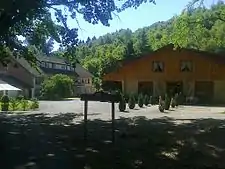 Hotel Villa Baviera in February 2014 | |
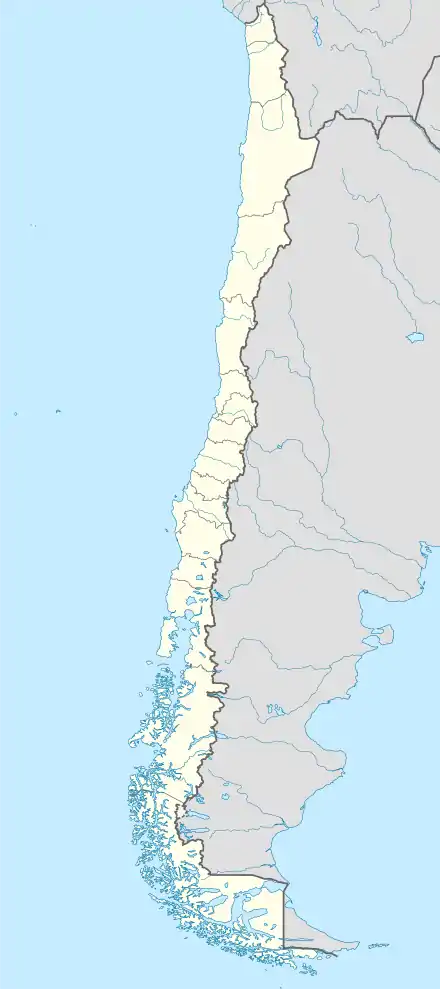 Location of Colonia Dignidad (now Villa Baviera) in Chile | |
| Coordinates | 36°23′13″S 71°35′17″W |
| Other names | Villa Baviera |
| Known for | Internment and murder of dissidents during Pinochet's military dictatorship |
| Location | 35km east of Parral |
| Built by | Paul Schäfer's sect |
| Operated by | Paul Schäfer |
| Commandant | Paul Schäfer |
| First built | 1961 |
| Operational | 1961 - 2007 (as sect's operation place)[1] 1973 - 1985 (as concentration camp of Pinochet's dissidents) |
| Killed | unknown |
| Notable inmates | Boris Weisfeiler (alleged) |
| Notable books | Das Blendwerk: Von der "Colonia Dignidad" zur "Villa Baviera" |
The main legal economic activity of the colony was agriculture; at various periods it also was home to a school, a hospital, two airstrips, a restaurant, and a power station.

Colonia Dignidad's longest continuous leader, Paul Schäfer, arrived in the colony in 1961.[2] Schäfer was a fugitive, accused of child molestation in West Germany. The organization he led in Chile was described, alternatively, as a cult or as a group of "harmless eccentrics". The organization was secretive, and the Colonia was surrounded by barbed wire fences, and featured a watchtower and searchlights, and was later reported to contain secret weapon caches. External investigations, including efforts by the Chilean government, uncovered a history of criminal activity in the enclave, including child sexual abuse.[3] Its legal activities were supplemented by income related to weapons sales and money laundering. Reports from Chile's National Commission for Truth and Reconciliation, indicate that a small set of the many individuals abducted by Pinochet's Dirección de Inteligencia Nacional during his rule were held as prisoners at Colonia Dignidad, some of whom were subjected to torture, and that some Colonia residents of the time were participants in the atrocities.
In 1991, the name of the settlement was changed to Villa Baviera. According to the census of 2002, there were 198 inhabitants of the colony.
As of 2005, Villa Baviera´s leaders insist that it is a different, changed organization and have attempted to modernize the colony; by allowing residents to leave in order to study at university, and by opening the colony to tourism, attracting visitors due to its past.[4][5][6]
Location
Located in a remote area in the Maule Region of central Chile, Colonia Dignidad was ~35 km southeast of the city of Parral, on the north bank of the Perquilauquén River. The full name of the colony from the 1950s was Sociedad Benefactora y Educacional Dignidad ("Charitable and Educational Society 'Dignity' "). At its largest, Colonia Dignidad was home to some three hundred German and Chilean residents, and covered 137 square kilometers (53 sq mi).[7]
History
The first inhabitants of Colonia Dignidad arrived in 1961, brought by German citizen Paul Schäfer, who was born in 1921, in the town of Troisdorf. Schäfer's first employment in Germany was as a welfare worker for children in an institution of the local church, a post from which he was fired at the end of the 1940s; he, then, faced accusations of sexual abuse against children in his care.[8] While these first reports led to his dismissal, no criminal proceedings were initiated. Afterwards, he worked as an independent preacher, forming a community in Gronau, which is an organization dedicated to working with children at risk. He quickly acquired great influence over his members, who had to perform hard farm work without pay. Shortly thereafter, stories reemerged relating to the earlier allegations of pedophilia against him. As a result, in 1961, Schäfer organized the emigration of several hundred members of their community to Chile.
Problem observed
The colony intended to project to the outside world an image of harmony, order and an inclusive system of communal work. This was emphasized by the work of its own press operations who were recording and broadcasting videos showing their happy residents amid celebrations and commemorations: men dedicated to farm work, women and girls embroidering or preparing butter.
However, Schäfer's propaganda efforts were again and again overshadowed by allegations of people escaping from the colony and obtaining asylum in Germany. The first, Wolfgang Müller, fled in 1966 and first exposed the atrocities that occurred within the colony. Müller obtained German citizenship and worked for a newspaper, soon becoming an activist in Germany against the leaders of Colonia Dignidad, and finally became the president of the foundation dedicated to the support of victims in Chile.
In the following year, he freed another inhabitant of the colony, Heinz Kuhn, who confirmed the allegations previously made by Müller, and provided more information on abuses. However, these first allegations were rejected by politicians and were emphatically denied due to their ties with the management of the Colony in their preparation of the military coup of September 11, 1973, as demonstrated later in Chilean court cases.
Secret detention camp
Before officially moving his organization to Chile, Paul Schäfer requested that the Chilean government exempt him from paying taxes and grant him asylum as long as he helped with gaining political intelligence.[9] The Rettig Commission noted a wealth of information supporting the accusations of the use of the laundry owned by Colonia Dignidad for detention and torture of political detainees during Pinochet's military dictatorship. This farm, commonly known as Colonia Dignidad, is within Parral, on the banks of river Perquilauquén, near Catillo. The Commission has also noted that other sources concluded Colonia Dignidad was used at a minimum as a detention center for political prisoners. Among these sources are spokesmen for the Government of the Federal Republic of Germany, and the Working Group on Enforced or Involuntary Disappearances. The Rettig Commission ultimately based its conclusions on evidence that it examined directly.
In these underground prisons, the captives were tortured in numerous ways, including mutilation from dogs and electric shocks. There is speculation that the extent of Schäfer's involvement with Pinochet has not yet been fully disclosed.[7] Schäfer's 2005 arrest saw more than 500 government files of missing detainees hidden in the ‘bodega de las papas’ (‘potato cellar’ in English). Each of these files contained details of severe human rights violations committed under Schäfer's supervision in collaboration with Pinochet. In the late 1970s, Pinochet allegedly ordered for the mass graves containing hundreds of murdered detainees to be unearthed and for the bodies to be either thrown into the sea or burned.[9]
Claims of German Intelligence Service assistance
Journalist John Dinges has claimed that there was some degree of cooperation between the German Intelligence Service and Colonia Dignidad, including creation of bunkers, tunnels, a hospital, and runways for the decentralized production of armaments in modules (parts produced in one place, other parts in another). This subject was proactively hidden, because of the problems experienced at the time associated with Argentina.
Democratic transition
Chile took a turn to democracy in 1990 after 17 years of dictatorship, but Colonia Dignidad remained unchanged. Allegations of abuses and humiliations that occurred inside the colony increased. National and international pressure intensified, but each time the police tried to conduct an investigation at the site they were greeted with a wall of silence. Colonia Dignidad authorities remained powerful and also had allies in the army and among the Chilean far-right, who would warn them in advance when the police were preparing to visit the site.
Slowly, Chilean public awareness began to change, creating a growing feeling of resentment towards the place, which many began to perceive as an independent state, or an enclave within Chile.
Life under Schäfer leadership
Before coming to Chile, Schäfer had attempted to start an orphanage in Germany, but two mothers living there accused him of molesting their children, so to escape judicial consequences, he fled to Chile.[10] Schäfer arrived in Chile in 1961 with around 70 followers, and a number of kidnapped children. The colony continued to ‘import’ children from Germany and the surrounding areas until the end of Schäfer's leadership. Colonia Dignidad grew to have about 350 people, around 100 of whom were children.[11] Those on the side of the colony said that it was a harmless organization, but, those against it recounted it as tyrannical in structure, and highly restrictive in terms of interaction between genders and in expression of sexuality, with a reportedly aging population. The perimeter of the colony was made up of barbed wire, searchlights, and a watchtower.[7] Today the colony is not as isolated as it was under Schäfer's leadership; Schäfer made great efforts to keep the colony as isolated as he could. The road to the colony cut through farmland and forest, and brought the traveler to a large barbed-wire fence that was generally heavily protected. Inside, however, the colony seemed fairly normal, though a bit old-fashioned:
The village had modern apartment complexes, two schools, a chapel, several meetinghouses, and a bakery that produced fresh cakes, breads, and cheeses. There were numerous animal stables, two landing strips, at least one airplane, a hydroelectric power station, and mills and factories of various kinds, including a highly profitable gravel mill that supplied raw materials for numerous road-building projects throughout Chile. On the north side of the village was a hospital, where the Germans provided free care to thousands of patients in one of the country’s poorest areas.[10]
Schäfer, despite living in Chile for most of his adult life, spoke little Spanish, as only German was spoken inside the colony. He was described as having a very serious demeanor, and rarely smiled, but was considered to be quite charismatic nonetheless. He made great efforts to illustrate Colonia Dignidad as a utopian paradise, seemingly frozen in a time before World War Two.[10] In reality, Schäfer ran a fear-based colony where members were barred from interacting with the world outside the community, and a few were armed to protect the community against possible outside attacks.[9] The inhabitants lived under an abnormal authoritarian system, where in addition to minimal contact with the outside, Schäfer ordered the division of families (parents did not talk to their children, or did not know their siblings). It prohibited all kinds of relations, sentimental or conjugal, among adult women and men, and segregated the living quarters of each sex. Schäfer sexually abused children and some were tortured, as is clear from the statements of the German Dr. Gisela Seewald, who admitted the use of electroshock therapy and sedatives that her boss had claimed were placebos. Members were often encouraged to confess to him both their own sins, and the sins of others that they had witnessed. Supposed sinners were often publicly outed and shamed during gathering times and meals. Women were thought to be inherently sinful, plagued by sexuality, thus the justification behind separating the men from the women. Schäfer often dictated forming romantic relationships, as far as saying when to get married and have children. Most of the time, however, conceptions of family inside the colony were based not on genetics, but on loyalty to Schäfer, who self-identified as ‘The Permanent Uncle.’ When a child was born, it would not stay with its biological parents, but rather be raised by nurses in a group called ‘The Babies.’ Each stage of life was categorized like this, with the following stages being ‘The Wedges’ (up to age 15), ‘The Army of Salvation,’ ‘The Elder Servants’ by age 30, and lastly, by age 50, ‘The Comalos.’ This was done in an effort to give everyone an exact role in the colony's order. Inhabitants lived in groups of about six, and all wore similar German 30s-style clothing. Each person would work 12+ hours a day, receiving no payment, but doing so rather for the sake of Colonia Dignidad.[10]
The colony had a school and hospital in the enclave which offered support to rural families through free education and health services. This would, ultimately, create support in case the colony was attacked. However, there are many cases uncovered in recent years that refer to illegal adoptions of children from families residing in the surrounding areas by the German hierarchy in order to deliver on the promise of free education. Locals around the colony generally knew Colonia Dignidad to be made up of hygienic, hard-working individuals who led a very structured life.[10]
Atrocities
Sexual abuse
In 1996, Schäfer fled child sex abuse charges in Chile,[8] escaping arrest until 2005.[12] The previous year, in his absence, a Chilean court had convicted him of child abuse, together with 26 other cult members.[13] In 2006, he was sentenced to 20 years in prison.[14] He died in prison of a heart ailment, on 24 April 2010, at the age of 88. At the time of his death he was still under investigation for the 1985 disappearance of mathematician Boris Weisfeiler, an American citizen who went missing while hiking near Colonia Dignidad.[15]
Torture and murder
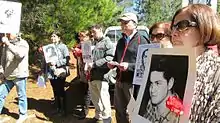
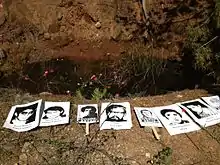
During the military dictatorship of Augusto Pinochet, from 1973 to 1990, Colonia Dignidad served as a special torture center. In 1991, Chile's National Commission for Truth and Reconciliation concluded that a number of people apprehended by the DINA were held at Colonia Dignidad, and that some of the colony's residents actively helped the DINA torture some of the captives.[10] Colonia Dignidad's involvement came to light as early as an October 1976 report from the United Nations Ad Hoc Working Group on Chile, as referenced in a March 1977 Amnesty International report, "Disappeared Prisoners in Chile", with the latter report describing the evidence in this way:
Another DINA detention center described in the [U.N.] document, in which it is alleged that experiments in torture are carried out, is Colonia Dignidad, near the town of Parral…[4]
Prisoners being tortured in the tunnels under Colonia Dignidad were each interrogated to gain an understanding of their personality in order to gauge the appropriate torture technique. These techniques led to a number of afflictions lasting indeterminate periods of time.[11] As many as 100 of the citizens taken to Colonia Dignidad by the DINA were murdered at the colony.[16]
Member abuse
Some defectors from the colony have portrayed it as a cult in which the leader Paul Schäfer held the ultimate power. They claim that the residents were never allowed to leave the colony, and that they were strictly segregated by gender. Television, telephones and calendars were banned. Residents worked wearing Bavarian peasant garb and sang German folk songs. Sex was banned, with some residents forced to take drugs to reduce their desires. Drugs were also administered as a form of sedation, mostly to young girls, but to males as well. Severe discipline in the forms of beatings and torture was commonplace: Schäfer insisted that discipline was spiritually enriching.
There are more than 1,100 desaparecidos (disappeared persons) in Chile, some taken to the Colony where they were tortured and killed. One of them is a U.S. citizen, Boris Weisfeiler, a Soviet-born mathematics professor at Pennsylvania State University. Weisfeiler, then 43 years old, vanished while on a hiking trip near the border between Chile and Argentina in the early part of January 1985. It is presumed that Weisfeiler had been kidnapped and taken to the Colony where he was tortured and killed.[17] In 2012, a judge in Chile ordered the arrest of eight former police and army officials over the kidnapping of Weisfeiler during the Pinochet years, citing evidence from declassified US files.[18] In 2016, the case was closed and the men were freed when a judge ruled that Weisfeiler had indeed been abducted, but that it was only a common crime, long past the statute of limitations, instead of a human rights violation.[19]
One of the first instances of abuse allegations was in 1966 from escapee Wolfgang Müller, who had been sixteen when he came to the colony. He claimed that he was forced into slave labor, received regular harsh beatings, and was molested by Schäfer on multiple occasions. Müller said that former Nazis were part of the colony as well.[11]
Weapons violations
In June and July 2005, Chilean police found two large illegal arms caches in or around the colony. The first, within the colony itself, included three containers with machine guns, automatic rifles, rocket launchers, and large quantities of ammunition, some as many as forty years old but with evidence of recent maintenance.[20][21] This cache was described as the largest arsenal ever found in private hands in Chile. The second cache, outside a restaurant operated by the colony, included rocket launchers and grenades.
In January 2005, former Chilean secret police operative Michael Townley, then living in the United States under a witness-protection program, acknowledged to agents of Interpol Chile links between DINA and Colonia Dignidad. Townley also revealed information about Colonia Dignidad and the army's Laboratory on Bacteriological Warfare. This last laboratory would have replaced the old DINA laboratory at Vía Naranja de Lo Curro hill, where Townley worked with the chemist Eugenio Berríos. Townley also gave proof of biological experiments, related to the two aforementioned laboratories, on political prisoners at Colonia Dignidad.[22]
Nazi ties
Both the Central Intelligence Agency and Simon Wiesenthal have presented evidence that Josef Mengele, the infamous Nazi concentration camp doctor, known as the "Angel of Death" for his lethal experiments on human subjects was present at the colony.[23]
The Nazi underground in South America was established some time before World War Two. Juan Perón provided shelter to some escaped Nazi criminals. Nazi sympathy in South America decreased, until Pinochet took power.[11] It was suggested that part of the intense racism, anti-Semitism, and classism in Chile can be attributed to Nazi presence.
The high concentration of Germans in Chile shaped the country's overall attitude towards subjects like education and military. A few of the Germans who immigrated to Chile in the 1960s were ex-Nazis led by Paul Schäfer.[9] Colonia Dignidad was a “Nazi stronghold protected by the Chilean government[...].”[2] Former members of the SS and Gestapo had the job of demonstrating Nazi torture methods to the secret police of Chile. Many of Schäfer's followers who had Nazi pasts joined him to escape post-World War Two war crime investigations.[2] The presence of Colonia Dignidad had an effect on the general political opinion of the surrounding areas, and the government as well because of this, considering the political ties between Colonia Dignidad and the Chilean government.[24]
Legal proceedings
In 2004, a Chilean court convicted Schäfer and 26 other cult members of child abuse.[13] In 2006, Schäfer was sentenced to 20 years in prison.[14]
In early 2011, Hartmutt Hopp, considered to be Schäfer's "right-hand-man" at Colonia Dignidad, was placed under house arrest in Chile while awaiting trial for human rights crimes.[16] In May 2011, Hopp fled Chile on board a helicopter, later making his way to Germany.[16] In June 2016, prosecutors in Germany petitioned a court to enforce a 5-year prison sentence that Hopp was sentenced to in absentia in Chile.[25][26] In May 2019, German prosecutors announced that they had dropped their investigation into Hopp and Reinhard Döring. In January 2020, a lawyer for the victims, Petra Schlagenhauf, lodged a complaint seeking to have the investigation reopened.[27][28][29]
At the time that Hopp fled Chile, 10 other cult members were out on bail awaiting trial on various charges. Fearing that they would also flee the country, their bail was immediately revoked and they were taken into custody.[16]
In 2010, Chilean authorities opened an investigation into the events occurring in the colony during the 1990s, resulting 19 months later in the Supreme Court issuing a unanimous ruling to prosecute 16 Chilean and German members of the colony.[30] On 28 January 2013, six former leaders of the colony were sentenced to prison, while the remaining 10 were found guilty of lesser crimes and given probationary sentences.[30]
Villa Baviera era
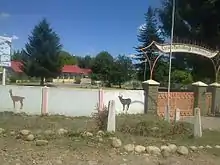
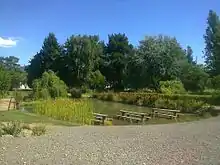
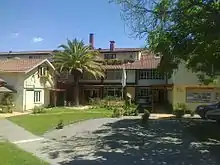
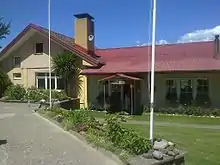
In 1991, the name of the settlement was changed to "Villa Baviera".[31] There is still a colony on the site, but its current leaders insist that changes have taken place. The colony has been modernized, residents are allowed free ingress and egress, and some study at university.[5] As of 2019 Villa Baviera is operated as a tourist resort.[31]
See also
- Klaus Schnellenkamp
- Colonia, a 2015 film set primarily in Colonia Dignidad.
- Hunting Hitler, season 2 episode 8 "Nazi Colony".
- The Tunnel, whose second season involves past Colonia Dignidad crimes.
- Dignity (TV series), Chilean-German thriller television series about the investigation against Paul Schäfer.
- The Wolf House, Chilean animated film about a young woman who escaped from Colonia Dignidad.
References
- de Sena, Donato (2010-12-08). "Villa Baviera, da colonia nazista a villaggio per turisti". Giornalettismo (in Italian). Retrieved 2019-07-30.
- Infield, Glenn, Secrets of the SS, 1981, p. 206.
- Staff writer (2013-12-15). "The Colony: Chile's dark past uncovered". Al Jazeera. Retrieved 2014-01-24.
- Amnesty Staff (1977-03-01). "Disappeared Prisoners in Chile". Amnesty International Publications. Retrieved 2016-04-21.
Another DINA detention center described in the same document, ...
- Reel, Monte (2013-02-27). "Villa Baviera: Chile's Torture Colony Tourist Trap". Bloomberg News. Retrieved 2016-09-05.
- Oppenheim, Marella (2018-05-02). "Excavations at Chile torture site offer new hope for relatives of disappeared". The Guardian. Retrieved 2019-07-30.
- Branford, Becky (2005-03-11). "Secrets of ex-Nazi's Chilean fiefdom". BBC News. Retrieved 2016-04-21.
- Hannaford, Alex (2016-07-03). "What happened in Colonia? Inside the terrifying Nazi cult that inspired Emma Watson's new film". The Daily Telegraph. Retrieved 2019-05-28.
- Cassigoli, Rossana (May 2013). "Sobre la presencia nazi en Chile". Acta Sociológica (in Spanish). 61: 157–177. doi:10.1016/S0186-6028(13)70994-0.
- Falconer, Bruce (2008-09-01). "The Torture Colony". The American Scholar. Retrieved 2019-05-10.
- Levenda, Peter (2002). Unholy Alliance: A History of Nazi Involvement in the Occult. London: Bloomsbury Academic. ISBN 0826414095.
- Porteous, Clinton (2005-03-11). "Fugitive Chile cult leader held". BBC News. Retrieved 2012-02-04.
- Harding, Luke (2005-03-12). "Fugitive Nazi cult leader arrested". The Guardian. Retrieved 2008-04-02.
- Conway, Jane (2006-05-25). "German Cult Leader in Chile Gets 20-Year Sentence". Deutsche Welle. Retrieved 2016-09-07.
- Brown, Emma (2010-04-25). "Paul Schaefer, 89, ex-Nazi preacher jailed for abuse, dies". The Washington Post. Retrieved 2016-09-07.
- Reynoso-Palley, Amanda (2011-05-25). "Human Rights & Law News: "Colonia Dignidad Cult's Second-In-Command Flees Chile"". The Santiago Times. Archived from the original on 2015-04-02. Retrieved 2015-02-28.
- Weisfeiler, Olga; Weisfeiler, Lev. "Professor Boris Weisfeiler Has Been Missing in Chile since 1985". weisfeiler.com. Retrieved 2016-04-21.
- Staff writers (2012-08-22). "Judge in Chile orders arrests over missing US hiker". BBC News. Retrieved 21 April 2016.
- Long, Gideon (2016-04-10). "Missing in Chile: What happened to Boris Weisfeiler?". BBC News. Retrieved 2019-07-31.
- "Arsenal encontrado en Colonia Dignidad". War2Hobby.cl (in Spanish). 2005-06-16. Archived from the original on 2009-09-12. Retrieved 2019-07-31.
- Staff writers (2005-06-14). "Policía civil encontró dos depósitos de armas en ex Colonia Dignidad". Radio Cooperativa (in Spanish). Retrieved 2012-02-04.
- Staff writers (2005-03-30). "Michael Townley fue interrogado por muerte de Frei Montalva". Radio Cooperativa (in Spanish). Archived from the original on 2012-07-29. Retrieved 2016-04-21.
- Infield, Secrets, p. 207.
- Valades, Adriana; Garza Elizondo, Humberto (Summer 1992). "Las Relaciones Políticas y Culturales Entre Alemania y América Latina". Foro Internacional. 32 (4): 455–466 – via JSTOR.
- Stirken, Norbert (2016-07-27). "Sektenarzt aus Krefeld: Hopp könnte laut Regierung Täter und Opfer zugleich sein". Rheinische Post (in German). Retrieved 2016-09-05.
- Staff writers (2016-06-08). "German court asked to jail Chile sect doctor Hartmut Hopp". BBC News. Retrieved 2016-09-05.
- Staff writers (2019-05-08). "Colonia Dignidad: Germany drops probe into sect doctor". BBC News. Retrieved 2020-09-05.
- Ute Löhning (2020-01-14). "Zeugen wurden nicht gehört". Die Tageszeitung (in German). Retrieved 2020-09-05.
- "Colonia Dignidad Remains a Dark Chapter of German Legal History". European Center for Constitutional and Human Rights. Retrieved 2020-09-05.
- Roberts, Laina (2013-01-29). "Chile Abroad: Colonia Dignidad victims file US $120 million lawsuit against Chile". The Santiago Times. Archived from the original on 2015-04-02. Retrieved 2015-02-28.
- "Colonia Dignidad: Germany to compensate Chile commune victims". BBC News. 18 May 2019.
Bibliography
- Infield, Glenn (1981). Secrets of the SS. New York, NY: Stein and Day. ISBN 0812827902.
Further reading
The following citations are presented in inverse date order, newest published to oldest. They are offered for improvement of the article, and to allow readers further information on the subject.
- Douglas, Marcela. "Hopes and Horror. A German community in Chile." UiT The Arctic University of Norway, 2014. ISBN 9788282441148.
- "Tales of torture: A former member of Chile's national intelligence agency describes some of the methods used against political prisoners". AlJazeera. December 15, 2013. Retrieved January 24, 2014.. The relevance of this article us uncertain.
- Levenda, Peter (Kindle ed., 2012). Ratline: Soviet Spies, Nazi Priests, and the Disappearance of Adolf Hitler. Ibis Press. ASIN B0081HDYQ6.
- Klaus Schnellenkamp. Geboren im Schatten der Angst, Ich überlebte die Colonia Dignidad. München: Herbig Verlagsbuchhandlung, 2007, 238 S., ISBN 9783776625059.
- Heller, Friedrich Paul. Lederhosen, Dutt und Giftgas: Die Hintergründe der Colonia Dignidad. Stuttgart: Schmetterling Verlag, 2005. ISBN 3-89657-093-5
- Vedder, Efrain & Lenz, Ingo. Weg vom Leben. Berlin: Ullstein, 2005, ISBN 3550076134.
- "BBC NEWS - Americas - German held over 'Chile torture'". bbc.co.uk. 27 December 2005. Retrieved 21 April 2016.
- "BBC NEWS - Americas - Chile officials take over colony". bbc.co.uk. 27 August 2005. Retrieved 21 April 2016.
- "Chile discovers weapons cache on cult grounds". The New Zealand Herald. 16 June 2005. Retrieved 21 April 2016.
- "BBC NEWS - Americas - Fugitive Chile cult leader held". bbc.co.uk. 11 March 2005. Retrieved 21 April 2016.
- Peter Kornbluth, The Pinochet File: A Declassified Dossier on Atrocity and Accountability, Boris Weisfeiler, pp. 7 e.a. New York: The New Press, 2003, ISBN 9781595589958.
- Gero Gemballa: Colonia Dignidad. Ein Reporter auf den Spuren eines deutschen Skandals. Frankfurt/New York: Campus-Verlag, 1998, 213 S., ISBN 3593359227.
- Levenda, Peter (1995). Unholy Alliance: History of the Nazi Involvement With the Occult, 1st edn., Avon Books. ISBN 0380777223. See also 2nd ed., 2002, Continuum International Publishing Group. ISBN 0826414095.
- Friedrich Paul Heller. Colonia Dignidad. Von der Psychosekte zum Folterlager. Stuttgart: Schmetterling Verlag, 1993, ISBN 392636999X.
- Gero Gemballa. Colonia Dignidad: ein deutsches Lager in Chile. Reinbek bei Hamburg: Rowohlt, 1988. 173 S., ISBN 3499124157.
- John Dinges y Saul Landau. Asesinato en Washington, Pantheon 1980, Planeta 1990 (sobre el caso Letelier).
- Álvaro Rojas. El secreto de Colonia Dignidad.